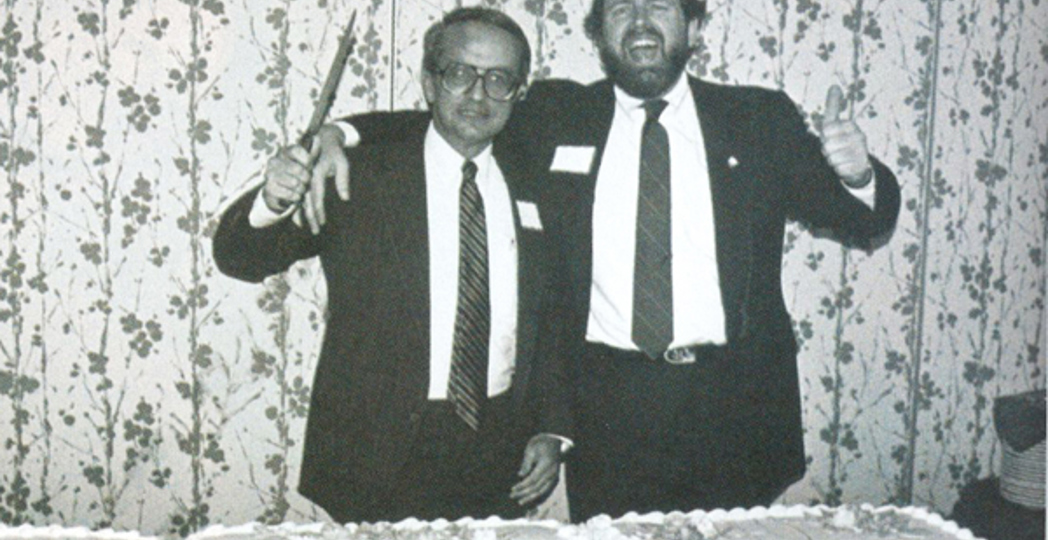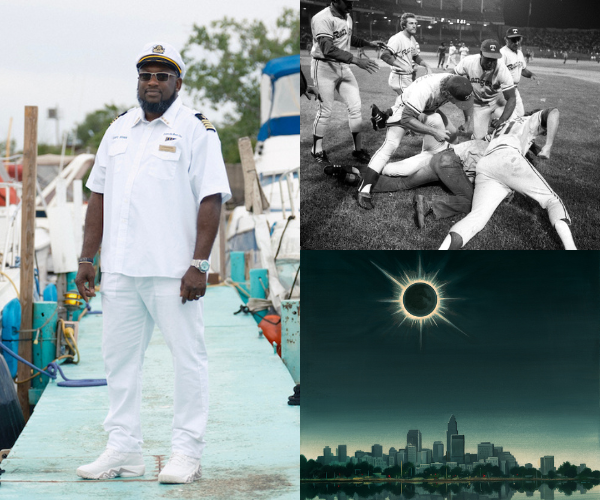Cut Loose, Kid: The Birth of a City Magazine
by Lute Harmon Sr. | Dec. 1, 1997 | 5:00 AM

In 1971, I was a 32-year-old advertising copywriter for the Cleveland Electric Illuminating Co., working in the department responsible for attracting businesses to Cleveland.
Part of my job was checking out the competition, so to speak, so I received magazines from cities like New York, Philadelphia and Washington, D.C. I loved those magazines – they made the cities seem so vital, something that, at the time, Cleveland was not. Something was always happening in New York and Washington. It sounds crazy now, but I began to wonder whether, if Cleveland had a magazine, things would start happening here too.
I can almost pinpoint the moment when Cleveland Magazine was conceived: My wife and I were driving to Florida to visit my parents, and I’d brought along three or four of these city magazines as reading material. I turned to my wife and said: “Cleveland needs a magazine.”
She just shrugged and said it was worth considering. I’m sure she thought I’d forget the whole scheme as soon as we’d passed through Georgia.
But not long after that trip, I started asking people what I’d need to do to start a magazine. “You have to have a prototype,” they said. I wasn’t sure what a prototype should look like, but with the help of an artistic CEI coworker, we transformed an issue of New York magazine into Cleveland Magazine. Sort of. We actually just changed every story by putting “Cleveland” in place of “New York” in the headlines.
My next step, I was told, was to raise money, and the man to see was Oliver Emerson, whose Emerson Press printed CEI’s monthly magazine and annual report. I called him up and said, “Mr. Emerson, you don’t know who I am, but I wondered if I could meet with you to tell you about an idea I have.” Ollie and I met a couple of weeks later. I told him about my magazine idea, and almost immediately he said, “Great! Let’s do it.”
“What?” I exclaimed.
“Let’s do it,” he said again. “What we need is a business plan.” I had no clue what a business plan was and had no more idea of how to write one than I did of how to design a magazine prototype. But while I sat there wondering whether Ollie was serious or just goofing around with an idealistic kid, he was talking about getting some people together at the Union Club. “You stand up, and you pitch ’em,” he said. “If you pitch ’em right, you have yourself a magazine.”
This was November 1971. The next month, my wife and I headed off for a brief Christmas vacation. I thought it would be months, if then, before I’d hear from Ollie Emerson about the Union Club kaffeeklatsch. But when we got to my parent’s house in Florida, the phone rang — it was Ollie. He’d set up a meeting for Dec. 27.
“Twenty of the most influential people in Cleveland are coming to hear you pitch,” he said. If I ever doubted Ollie’s influence and connections, when he started rattling off names like Del DeWindt from Eaton Corp. and Nick Mileti of the Cleveland Cavaliers, there wasn’t a shred of doubt in my mind that Ollie had meant what he’d said to me a few weeks earlier. These people were friends of Ollie’s — seriously heavy-hitters, prominent people I never would have met in a million years if not for him.
I had no idea how to plan this presentation, still hadn’t figured out how to write a business plan and certainly had no idea what should be included in it. But what choice did I have? I sat down and wrote a plan, hired a typist and worked for two days and two nights to finish the thing. Then I flew up to Cleveland, walked into the Union Club not having slept in the last 48 hours and made my presentation. When I was done, I asked if there were any questions.
Nick Mileti raised his hand. “This is never going to work,” he said.
Some of the others said, “Nick, go easy on the kid. Why do you say it won’t work?”
He said, “Here’s this business plan” — and I had used Nick as an example of what could be done in Cleveland with a little initiative and money — “and the kid spelled my name three different ways.”
Thank goodness he laughed, and everybody relaxed. Before I left, I had one check in my pocket. We went on to bring in about 20 investors, huge names from companies like Bonne Bell; Jones, Day, Reavis and Pogue; and American Shipbuilding — the common bond being that they all knew Ollie. They probably owed him something, for all I know, but at the time all that mattered was that they were interested in helping a thirtysomething kid with no publishing-industry experience start a city magazine.
After Christmas break, I went back to work at the Illuminating Co. I didn’t know what else to do, really, because the magazine was still in a dream stage as far as I was concerned. I hadn’t been back more than a couple of hours when Bob Bridges, the vice president of CEI’s advertising department, who I never would see in the normal course of my day, said he wanted to see me.
Bob sat there with this package on his desk, a plain yellow envelope, drumming his fingers on it. “Lute Harmon. Lute Harmon. How many Lute Harmons do you think there are in Cleveland, Ohio?”
I said, “I doubt, Bob, that there are any other Lute Harmons in Cleveland.”
“That’s what I figured,” he said. “And I’ll be a son of a gun, but I’ve got this plan for a magazine here, Cleveland Magazine, and it’s got your name on it. Do you think somebody’s using your name?”
I said, “Gee, Bob, no. That’s me.”
“Well,” he said, “I guess you have a decision to make, don’t you?”
I ran back to my office and called Ollie, who said: “Cut loose.” I’ll never forget those words.
Keep in mind that we didn’t have all the money committed at this point. We had no staff, no offices, not much except a prototype blatantly copied from New York and a handful of interested movers-and-shakers. I also had an infant son at home. This was really scary.
But for whatever reason — confidence? Egotism? Stupidity? — I quit my job. We bought a few used desks and opened Cleveland Magazine on the Emerson Press building’s second floor, which had been used for storage.
The magazine needed people to do everything — and I do mean everything. I think we even advertised for writers/secretaries. When Brigitte Straubs — who became our first editorial assistant — came to interview, my only remaining question after she’d convinced me of how great she was, was whether she owned a typewriter. She did, she got the job.
Our offices were hardly luxurious — they weren’t even holding together. Plaster flaked from the ceiling, which we didn’t realize until the editors noticed that their old manual typewriters weren’t working so well. Our solution was to cover the typewriters with newspapers before we left at night.
We didn’t have salespeople until the second or third issue, so at first I sold all the ads, going on calls with copies of other city magazines because we didn’t have out own yet. I sold the dream, which was something I don’t think I could do today. The dream was that by having a first-class city magazine, we were going to be a first-class city. That perception was extremely important to Clevelanders at the time. The magazine wanted to create excitement in a town that was headed nowhere.
And we did create excitement, I think, although it was tough those first few months. We had maybe six people on staff, and we all worked seven days a week. Our standard joke was to leave on Sunday afternoon and say, “Have a nice weekend.” After about nine months, our editor, Gary Griffith, who’d come to us from Case Western Reserve University and was responsible for our first cover story on Dennis Kucinich, said he’d had enough. He needed a break, and I needed a new editor.
As I look back at the history of the magazine, one of the most significant moves was hiring Mike Roberts. We became an important publication almost overnight. Here was a guy who’d been city editor at The Plain Dealer, a correspondent in Vietnam, a guy who really knew journalism — lived it, breathed it. He brought that to the magazine.
Not long after Gary left, Mike Roberts and I went to dinner at the Keg and Quarter. We talked about everything that was wrong with Cleveland. The more we talked, the more we drank, and the more we drank, the more we talked. I told him I wanted him to be editor, of course, but we somehow never quite got around to discussing the idea in detail.
Mike called me the next day and said he was sorry, but he couldn’t remember everything we’d discussed the night before. I saw my opening, “Well, Mike,” I said, “you accepted the job as editor of Cleveland Magazine.” But to this day neither of us is sure what we really talked about that night at the Keg and Quarter.
This city had such an inferiority complex then. Nothing good was happening. Or maybe I should say nothing was happening — period. I wrote in my first publisher’s column that Cleveland was “a slum-ridden, financially poor, ethnically divided city filled with stubborn people,” and I mean it.
In the early years of the magazine, we tried to elevate that image. As part of that, we pulled stunts like naming Dayton the armpit of the nation — we sent the city’s mayor a toilet plunger in a gift box. But a larger part was what Mike Roberts did for our editorial content. The first thing he did was bring in star politics reporter Ned Whelan, which gave us a one-two editorial punch unmatched anywhere at any city magazine.
Mike also brought in his wife, Pat Weitzel, to do restaurant reviews, which in retrospect is a large reason Cleveland Magazine is here today. Pat had been a food editor at The Washington Post and had impeccable credentials. She also said exactly what she felt. We had people running to newsstands to get their magazines and read her reviews. It got to a point where I’m sure Pat was the most feared woman in Cleveland. Mike and I were constantly going out and talking to restaurant owners about what we were doing and why, and of course they just claimed that we were putting them out of business. I would say that Pat Weitzel, just by herself, brought in 10,000 subscribers. No exaggeration.
But in the 1970s, we didn’t have to rely on stunts or tricks or even much promotion — the restaurant reviews and our stories got plenty of attention. Like the cover story we did in 1978, “Sex in the Suburbs” — nobody was doing that kind of thing. It truly was controversial. In fact, one of the women on the cover was a part-time model who lost her full-time teaching job because she posed for that picture. No one had dared write about the East Side/West Side rift, and when we did, this city was talking for years.
Another story that got people interested was a George Steinbrenner article we’d sat on for months, then ran the month Steinbrenner was indicted for illegal political contributions. Mike used to call them potboilers: We’d keep an eye on names popping up in the news, get the background information and when the issue came to a boil, we’d pop that story in the magazine. We’d bring everything together and make a whole story out of it.
Meanwhile, of course, we were trying to drum up even more interest — we needed more subscribers and more advertisers, like any start-up publication. One thing we did in the early years was send out a subscription offer around October saying that we’d guarantee that if you gave a subscription for Cleveland Magazine as a present, you would have a gift card by Christmas day.
Two days before Christmas, we had 300 gift cards that we couldn’t put through the mail in time. So on Christmas eve — it was snowing — my wife and I got in the car and went door to door delivering gift cards on the West Side, while one of the other staff people took the East Side. You should’ve seen the look on people’s faces when we’d knock on the door and say, “Here’s your Cleveland Magazine gift subscription.”
It was too easy starting the magazine. The tough part was keeping it going. Within a few years, we were viewed as one of the models of success in city magazines. We kept growing, year after year. In retrospect, this was probably as much a bad thing as it was good.
In 1978, we opened a magazine in Detroit, and two years later we started one in Tampa. By 1982, we’d added a magazine in Milwaukee. We had four magazines and thought we were going to conquer the world. The problem was that while everything might be fine in Cleveland on Monday, things in Detroit would be falling apart. Then on Tuesday, Detroit might be great, but Milwaukee would be having a crisis. There was no gain — financial or otherwise — to having four magazines in four different cities.
What we found is that city magazines are not widgets. You can’t manufacture them automatically, and they are very, very people intensive. Magazines are only as good as their people. It’s very difficult to have good people in two cities let alone three, let alone four.
As I think about Cleveland Magazine and its history, and everything the industry and the city have been through, I wonder about city magazines. Where are they going? What place do they have?
When we started, we were an alternative to The Plain Dealer, which didn’t want to tackle a lot of the stories we were doing about the Mafia and politics and government corruption and controversial social issues. We were providing stories that people couldn’t get anywhere else.
Things started changing as people moved to the suburbs and took their hearts and mind with them. Downtown was a workplace and occasional recreation area, period. They were far more interested in what was happening in Bay Village and Rocky River and Shaker Heights.
What we did in the 1970s and early ’80s wouldn’t fly now — there are so many other outlets for the same type of information. If we announced right now that we’re going to write an expose every month, people would ask “why?” Everybody does them.
On the other hand, there is still room for in-depth reporting in a city magazine. That’s a different type of journalism. People don’t go to a newspaper for a beginning, middle and end — they go there for what happened today. A city magazine can put the pieces together and flesh it out. We have the luxury of being able to come in every day and ask ourselves what we want to do to best appeal to our readers. We can concentrate our efforts on what they really want to read — not just what they have to or should read — or the kind of nuts-and-bolts data like weather and obituaries and sports scores that they can get elsewhere.
Hard to believe we’ve been around for 25 years. Even though things happened so fast in the beginning, and we grew so quickly, there were plenty of times that like any entrepreneurial organization, we felt that Cleveland Magazine days were numbered.
People ask me how we did it. I’m sure a part of it was just being too young to know better. But I’ve talked to a lot of people who’ve started things. You know what it is that makes them successful? You have to be a certain type. You have to be a little on the edge. You can’t be so security-conscience that you’re not willing to take a chance.
We took a chance. — as told to by Shari M. Sweeney
This story originally appeared in Cleveland Magazine’s 25th anniversary edition in December 1997.
Trending
-
1
-
2
-
3
-
4
-
5










